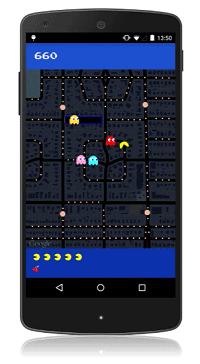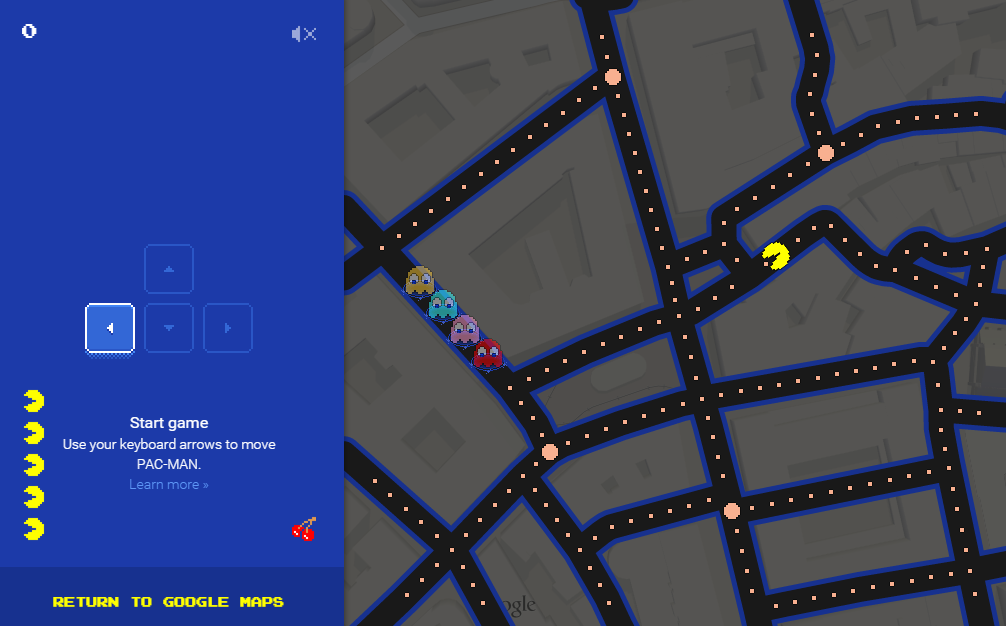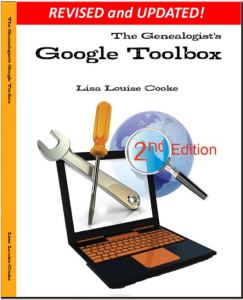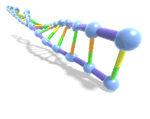by Lisa Cooke | Mar 31, 2015 | 01 What's New, Google, Google Earth, Maps
It may not help with genealogy, but Google Maps just got a lot more fun!
Yep, it’s PAC-Maps, and with this latest update you can find where NOT to go! Google has added imagery of “dangerous virtual beings, starting with Pinky, Blinky, Inky and Clyde. When navigating fruit-filled streets, determine at a glance which turns to pass to evade ghosts and get where you’re going safely. When you’re feeling a bit peckish, you can simply gobble up a few pac-dots or a cherry and keep on nommin’.”
I’m a little embarrassed to say how many hours I spent playing PAC-MAN in high school. Back then we had to hunch over a machine located next to the bathrooms at the local pizza parlor. Now you can take a break from your brick walls and walka walka walka around the world from the comfort of your desk. With PAC-Maps you can navigate select locations using the left, right, up or down arrows on your keyboard. Below is a screen shot from the desktop version:

Actually, PAC-MAN isn’t new to Googlers. Back on May 21, 2010 (yep, it’s official, I’m a Google geek) Google’s home page featured a desktop version that you can still play here.
 When you’re ready to head back to your genealogy brick wall, take my new book with you. The Genealogist’s Google Toolbox Second Edition makes Googling for your family tree easier than every!
When you’re ready to head back to your genealogy brick wall, take my new book with you. The Genealogist’s Google Toolbox Second Edition makes Googling for your family tree easier than every!
by Lisa Cooke | Mar 31, 2015 | 01 What's New, Adoption, images, United States
 Recently Genealogy Gems Premium member Katharine Ott wrote in this with newsworthy gem:
Recently Genealogy Gems Premium member Katharine Ott wrote in this with newsworthy gem:
“Recent adoption records are being released in Ohio. Such an exciting time for those adoptees yearning to connect with their bloodlines! Before the bill took effect, they allowed birth mothers to redact their names. Out of 400,000 only around 110 took them up on that. There’s also a preference form with the birth records where the mother can request not to be contacted. I wonder how often that might not be respected. It’s such an interesting situation for someone to be in.”
Wow, that’s huge news about Ohio adoption records! Thanks for the news, Katharine. She sent us this link to a local news story that covers the story. The Ohio Department of Health posted this webpage about ordering adoption records.
Want to learn more about accessing adoption records in any state? Check out the U.S. Adoption Research page at the FamilySearch wiki for a terrific overview and helpful links.
 Also, try running a Google search for the name of the state and the keywords adoption and genealogy. You’ll find lots of great resources, like this page on adoption records at the Pennsylvania state library or this online resource from the State Historical Society of Missouri.
Also, try running a Google search for the name of the state and the keywords adoption and genealogy. You’ll find lots of great resources, like this page on adoption records at the Pennsylvania state library or this online resource from the State Historical Society of Missouri.
The right Google search can shorten your search for the records you want! This tip brought to you by the newly-published, fully-revised and updated 2nd edition of The Genealogist’s Google Toolbox, Second Edition by Lisa Louise Cooke.
by Lisa Cooke | Mar 30, 2015 | 01 What's New, Canadian, Google, images, Newspaper
 Can Google help you search digitized newspapers you find online? Recently I heard from Garth in Ontario, Canada with a question like that. Here’s what he asked and here’s what I told him:
Can Google help you search digitized newspapers you find online? Recently I heard from Garth in Ontario, Canada with a question like that. Here’s what he asked and here’s what I told him:
“A friend found a digitized newspaper article by clicking on this link and going through various years–very time consuming! I’m thinking there has to be a better way with Google, but no luck. I think I have used most of your techniques from Genealogy Gems. Would appreciate any hints.”
 First of all, thanks to Garth for alerting us to an online local archive of Canadian newspapers, The Clarington Local Newspapers collection. I like making people aware of collections like this. Here’s what I told him:
First of all, thanks to Garth for alerting us to an online local archive of Canadian newspapers, The Clarington Local Newspapers collection. I like making people aware of collections like this. Here’s what I told him:
If the website had text transcriptions of articles then Google would have easily been able to grab the phrase “Arthur Levi Brunt” off any page. The search would be “Arthur Levi Brunt” or, even better, would be a site search, which would be formatted like this: site:http://vitacollections.ca/claringtonnews “Arthur Levi Brunt.” In Google site searches, you start with the word “site” with a colon, followed by the home page in which to search, followed by the exact phrase you want to search in quotes.
However, the Clarington Digital News website relies on its own built-in Optical Character Recognition (OCR) to spot and retrieve search terms on the digitized newspaper images. Google doesn’t have access to their OCR, and can’t apply OCR itself to images on the web (the pages on this site are images, not pdfs). So in this case, Google would not be able to locate the same article.
I did notice in looking at the Clarington News site that there is a search box, so your friend didn’t need to browse through the years looking for article on Arthur. Simply entering his name in site’s search box instantly brought up the relevant list in seconds. Here’s a link to that search, so you can see for yourself. Perhaps a few of the other newspaper articles found in that search will be of interest to your friend as well!
 Learn more about Google search strategies (Google site search is just one!) in my newly-revised, hot off the press 2nd edition of The Genealogist’s Google Toolbox, Second Edition. So many genealogy gems like these news articles are buried online: you just need to know how to harness the power of Google’s FREE tools to find them!
Learn more about Google search strategies (Google site search is just one!) in my newly-revised, hot off the press 2nd edition of The Genealogist’s Google Toolbox, Second Edition. So many genealogy gems like these news articles are buried online: you just need to know how to harness the power of Google’s FREE tools to find them!
by Lisa Cooke | Mar 29, 2015 | 01 What's New, African-American, DNA, images

Slave traders in Senegal. “Marchands d’esclaves de Gorée-Jacques Grasset de Saint-Sauveur mg 8526” by Rama – Own work. Licensed under Public Domain via Wikimedia Commons. Click to see image online.
Did you hear what has been discovered about the remains of three Caribbean slaves found on the island of St. Martin? Scientific techniques identified them as two males and one female, all between 25 and 40 years of age, who were buried around the mid-to-late-1600s.
But where were they from? It took DNA to help answer that question, with a process very similar to that used to identify our ethnic origins in DNA testing today.
First, scientists had to retrieve DNA from the sun-bleached, humidity-soaked remains. Their first stop: the teeth. Traditional DNA extraction and analysis methods failed, but results were found with a new method called whole genome capture. You can think of this method like unleashing an army of vigilantes on your DNA, each one tasked with bringing back a particular portion for analysis. While this method was far more successful, it still was only able to find 7% of the DNA of the best sample.
Second, they needed a reference population: a group of Africans to compare these results to in order to find a match. There is such a group assembled, which contains 11 of the likely 50 population groups that contributed to the slave trade. Keep in mind that in Africa, especially at that time, populations were not defined by geography as much as language. So when you hear African populations defined, it is often according to their relationship to one very large language group in Africa, called Bantu. There are really two groups: those that are Bantu speakers, and those who are not.
Even with the incomplete DNA and the limited reference population, the group was able to determine that two of the slaves belonged to non-Bantu speaking tribes, likely in present day Ghana or Nigera, while the third was Bantu speaking, possibly from northern Cameroon.
Finding ancient samples such as these, and having technology enough to analyze them, if even just a small part, has huge implications for the future of genetic genealogy, and family history. These kinds of genetic techniques can help place you in a genealogical relationship with another person, where your traditional genealogical methods could not. Family history, the substance and story of your relationship, inevitably follows.
I think Fatimah Jackson, a biologist and anthropologist at Howard University, said it best. “It seems to me that, as a scientist, the best way to ‘honor’ these unfortunate individuals is to allow their story to be told,” she says. “The story of a few can illuminate the condition of the masses.” We may never know the names and specific life histories of this woman and two men any more than we already do. But DNA has gotten us closer to telling at least some of their story. Click here to read the scientific study.
 Are you ready to let your genetics help tell your story? Learn more about DNA testing with my Getting Started in Genetic Genealogy Quick Guide, available now in the Genealogy Gems store. In fact, I have a whole series of Guides there on using DNA for genealogy. Check them all out!
Are you ready to let your genetics help tell your story? Learn more about DNA testing with my Getting Started in Genetic Genealogy Quick Guide, available now in the Genealogy Gems store. In fact, I have a whole series of Guides there on using DNA for genealogy. Check them all out!
If you’re ready for some one-on-one consulting to see what DNA can tell you about your family history, visit my website to learn more.
by Lisa Cooke | Mar 28, 2015 | 01 What's New, Cemeteries, images, Records & databases, Volunteer

Tyne Cot Cemetery. Photo by Sgt Jez Doak, RAF/MOD, via Wikimedia Commons. Click on image to visit that page.
You’ve probably searched for gravestone images at sites like BillionGraves and Find A Grave. What if you come up dry? Ask their volunteers to snap a photo for you. Here’s how to do it:
Make a BillionGraves Photo Request
“The Photo Reques t tool is a great new feature on BillionGraves,” says a recent BillionGraves blog post. “It has been optimized and revamped to help the hundreds of thousands of users and requests we have at BillionGraves! The user is looking for a particular headstone [at a specific cemetery] and is requesting that another BillionGraves volunteer that lives nearby, go find the headstone and take a photo of it for them.”
t tool is a great new feature on BillionGraves,” says a recent BillionGraves blog post. “It has been optimized and revamped to help the hundreds of thousands of users and requests we have at BillionGraves! The user is looking for a particular headstone [at a specific cemetery] and is requesting that another BillionGraves volunteer that lives nearby, go find the headstone and take a photo of it for them.”
You have to log in to the site to use the Photo Request tool (creating your free login is easy). Under the Tools tab, click on My Requests. The screen will look like what’s shown here. Then click on “Add Request” and follow the prompts. BillionGraves users near you will be notified and invited to help you out.
Make a Find A Grave Photo Request
According to the Find A Grave FAQ area, it looks like you can only request headstone photos for their existing memorial pages, many of which don’t currently have photos. (Idea: create a memorial page yourself if you don’t see one.) “If you would like to request a headstone photo of a memorial, just go to the memorial on Find A Grave. Click on the ‘Request A Photo’ button. This will bring up a new screen allowing you to add any notes that may help the photo volunteer locate the grave location within the cemetery….Then click the ‘Submit Photo Request’ button. Your request will be emailed to the 10 photo volunteers who live closest to the cemetery.” Read more details about this process here.
 Did you know you can use Google Earth to locate cemeteries? Click here to learn how. Use this feature to search for burial grounds near where your ancestors died–and maybe you’ll find them buried there!
Did you know you can use Google Earth to locate cemeteries? Click here to learn how. Use this feature to search for burial grounds near where your ancestors died–and maybe you’ll find them buried there!

 When you’re ready to head back to your genealogy brick wall, take my new book with you. The Genealogist’s Google Toolbox Second Edition makes Googling for your family tree easier than every!
When you’re ready to head back to your genealogy brick wall, take my new book with you. The Genealogist’s Google Toolbox Second Edition makes Googling for your family tree easier than every!







 t tool is a great new feature on BillionGraves,” says a recent BillionGraves blog post. “It has been optimized and revamped to help the hundreds of thousands of users and requests we have at BillionGraves! The user is looking for a particular headstone [at a specific cemetery] and is requesting that another BillionGraves volunteer that lives nearby, go find the headstone and take a photo of it for them.”
t tool is a great new feature on BillionGraves,” says a recent BillionGraves blog post. “It has been optimized and revamped to help the hundreds of thousands of users and requests we have at BillionGraves! The user is looking for a particular headstone [at a specific cemetery] and is requesting that another BillionGraves volunteer that lives nearby, go find the headstone and take a photo of it for them.”


